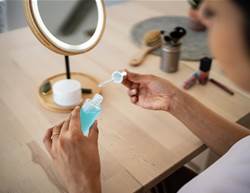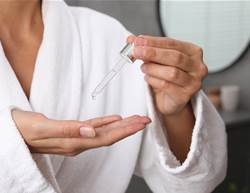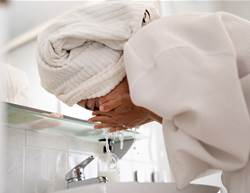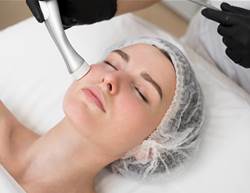It’s not your imagination: Fluctuating hormones from your teen years through to adulthood, including during pregnancy and menopause, can cause noticeable changes in your skin.
Here, some top dermatologists reveal what’s in store at each stage and the best methods for keeping skin healthy and radiant throughout every decade.
The teen's to 20's
Starting in the teenage years, and especially during puberty, hormones surge, says dermatologist Dr Ope Ofodile. “This increase causes skin’s sebaceous glands to produce more sebum, or oil, which can lead to acne and oily skin, especially on the cheeks and forehead,” she explains. Moving into the 20s, high hormone levels commonly persist and can present as painful cystic acne along the jawline and chin that’s often cyclical with menstrual cycles. Though this type of acne may flare around your period, “it can result in cysts that stubbornly last all month,” says dermatologist Dr Joyce Park.
TREATMENT To keep hormonal acne and excess oil at bay, incorporate an acne treatment cleanser that contains an active ingredient, like salicylic acid or benzoyl peroxide, into your routine twice per day in the morning and in the evening, suggests dermatologist Dr Marnie Nussbaum. For persistent or severe cases, visit a dermatologist. They can provide a medical regimen including prescription topical and oral treatments and in-office procedures.
Our pick: La Roche-Posay Effaclar Purifying Foaming Gel Cleanser
The 30's
In your 30s, hormonal acne can converge with new concerns, especially when combined with pregnancy. For some, acne may decline because of decreased oil production, Dr Nussbaum explains, but not everyone will be in the clear. “It’s a myth that adult females don’t experience acne,” Dr Ofodile says. “And during pregnancy, many women have increased hormone-related hyperpigmentation, known as melasma." Also, in your 30's, "you start to lose about 1 to 2 per cent of your skin's natural collagen each year due to a decline in hormones, which means less firmness and cellular turnover, leading to a dull appearance," Dr Nussbaum says.
TREATMENT Take a multi-pronged approach to your skin routine. “Now is the time to start a topical retinol treatment if you haven’t already, as it increases cellular turnover, reducing fine lines and helping support new collagen and elastin,” Dr Nussbaum says. (Stop using retinol when pregnant, breastfeeding or trying to conceive.) “You may also want to incorporate a glycolic acid cleanser or an alpha hydroxy acid toner to even out skin tone and texture, and an antioxidant serum with vitamins C and E and ferulic acid to brighten,” she adds. Post- pregnancy, “target hyperpigmentation with in-office treatments, such as chemical peels and microneedling, as well as prescription topical and oral brightening agents,” Dr Ofodile advises.
The 40's
During this decade, variations in skin’s structure and texture can become more pronounced. “Perimenopause begins in the 40s, so there’s a much steeper decline in hormones, and the relationship between oestrogen and progesterone is significantly fluctuating, causing more substantial changes in skin,” Dr Nussbaum says. “Collagen and elastin loss begins to ramp up, leading to reduced skin elasticity and more laxity, so you start to see deeper lines as well as increased volume loss and pore size.”
TREATMENT “It’s important to add a peptide serum or moisturiser to your regimen, as it further encourages new collagen and elastin formation,” advises Dr Nussbaum. “Consider also increasing the potency or usage frequency of retinol.” Pro options that are available include injectables, such as Botox, to relax wrinkles, and fillers to restore volume. There are also stronger laser treatments that can combat deeper lines and ultrasound or radio-frequency devices to tighten and lift skin.
Our pick: Boost LAB Multi-Peptide Anti-Ageing Serum 30ml
The 50's +
Beginning in the 50s and moving into subsequent decades, “oestrogen and progesterone levels drop drastically due to menopause, causing a 30 per cent loss of skin’s collagen all at once,” Dr Nussbaum says. “The decrease in oestrogen means a significant reduction in skin moisture and structural support, which can lead to dehydration and laxity.” It can also bring on sensitivity even in skin not previously prone to it. “Dryness from decreased oil production can cause irritation or eczema in some cases,” Dr Ofodile notes.
TREATMENT The goal is to retain elasticity and hydrate, says Dr Nussbaum. “Incorporate intensive hydration via a hyaluronic acid serum and moisturiser with ceramides to replenish the loss of lipids in the skin’s barrier.” Boost slower cell turnover by chemically exfoliating skin, which allows topical products to work more efficiently, she suggests (try an at-home or professional face peel). Meanwhile, professional treatment options some women may choose, again include injectables; tightening, lifting and volumising lasers; and radio-frequency and ultrasound devices.










